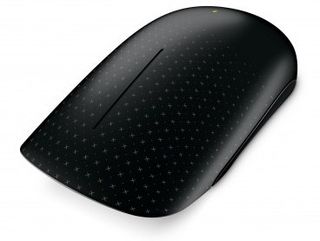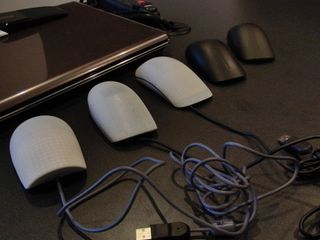How Microsoft made the Touch Mouse
And how it could develop in the future

Microsoft actually built a multi-touch mouse before Apple; at CES last year Stephen Bathiche, the head of the Microsoft Applied Sciences team, told TechRadar how his team designed a capacitive mouse and announced their research prototype at a conference a month before Apple announced the Magic Mouse.
The Microsoft hardware team has taken another year to turn that prototype into a mouse they're happy with, collaborating with researchers in the Applied Sciences team and the innovation development team at Microsoft Research in Cambridge (many of whom worked on projects like Microsoft Surface).
Hrvoje Benko of the Applied Sciences group showed TechRadar a selection of the prototypes from the three years he's been working on the 'Mouse 2.0' project. (Benko is behind the Lightspace project that uses a camera and projector "to make any surface, any wall - any body part! - into a Surface.")

CONCEPTS: Five different ideas for Mouse 2.0 - FITR mouse, Touch Mouse, the articulated franken-mouse, the hemisphere mouse and the mouse that shines a laser on your desk
The idea was to combine the good old mouse - which has been around since the early 1960s without much change in the way you use it - with the multi-touch features of Microsoft Surface. You can touch, grip and gesture with your whole hand, but the mouse reduces all your dexterity to a single cursor and right-click.
The Mouse 2.0 concepts went through several different kinds of touch sensors. A curved mouse made from acrylic sheet and an infrared camera (using the Frustrated Internal Total Reflection technique Perceptive Pixel uses for touch screens where the touch of a finger is detected because it allows reflected internal light out of the surface layer) looked good but could only sense the tips of your fingers.
Putting a diffused illumination infrared camera in a half sphere produced an unusual shape that had too much internal reflection and while it made users more creative in the way they used gestures it also made their hands get tired.
Get daily insight, inspiration and deals in your inbox
Get the hottest deals available in your inbox plus news, reviews, opinion, analysis and more from the TechRadar team.
An articulated mouse made from the innards of two mice bolted together, with knobs for two of your fingers sticking out at the front, was accurate and comfortable - but only allowed two-touch gestures.
One design with an infrared laser and camera detected your fingers touching the desk surface around the mouse, but only worked well if it was just the right size for your hand.
More like a mouse
In the end, the team picked a multi-touch mouse using a capacitive sensor, because that lets you have gestures without abandoning the familiar mouse shape (the sensor is small and you don't need to fit in a camera; it's not too expensive, either, because it's printed onto plastic using conductive ink).
"The benefits of the mouse are that it's comfortable and precise," Benko told us. "We didn't want to come up with something that meant people have to change the way they use the mouse. You can still point and click."
But when you click, it's not a button that's moving; it's the whole mouse (and that's more to give you feedback than to detect the click). "The whole surface of the mouse is a button so when you right-click and left-click it's really the same - but we detect where you click and that's what determines the click," he explained.

PROTOTYPES: Some of the many stages of designing the Touch Mouse, from the 3D printed (but fully working) first CAD prototype to the almost-finished wireless mouse. The diamond pattern is the multi-touch sensor - which is covered in later prototypes
Clicking and gesturing on the mouse surface is very comfortable thanks to the textured surface, which is a grid of tiny laser-etched dots. "This mouse will be used a lot", boasts Benko, "so we used laser etching; you cannot rub this off."
Mary (Twitter, Google+, website) started her career at Future Publishing, saw the AOL meltdown first hand the first time around when she ran the AOL UK computing channel, and she's been a freelance tech writer for over a decade. She's used every version of Windows and Office released, and every smartphone too, but she's still looking for the perfect tablet. Yes, she really does have USB earrings.
